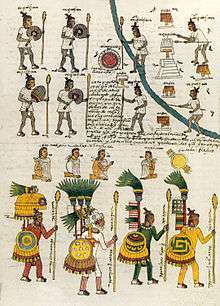Ichcahuipilli
The ichcahuipilli (known in Spanish as "escaupil")[1] was a Mesoamerican military armor, similar to the European gambeson, which was commonly used by the Aztecs and the Tlaxcalans. It was constructed of unspun cotton stitched between two layers of cloth.[2] The name is derived from the Nahuatl words ichcatl ("cotton") and huīpīlliand ("shirt").
Use
The armor was designed primarily to protect the torso of the warrior from obsidian swords, arrows and atlatl darts. It was made of successive layers of packed cotton and cloth, at least one inch thick, which would slow and trap the arrows, rather than divert them, like European plate armour. Because this armor was padded it protected well against the cutting blows of the macuahuitl and the heavy blows of batons.

It was a light garment sewn in diamond-shaped patterns, and worn directly over the skin. Usually, the most experienced warriors, especially those of the orders of eagle warriors and jaguar warriors used it to complement the tlahuiztli.[2]
The garment was so effective at stopping arrows, Spanish conquerors often adopted them instead of their own, heavier armor which was not as cool in the warmer, moisture filled weather of Mexico.[3][4]
Variations
The Ichcahuipilli was made in different designs. The most common was a vest style that covered the torso down to the hips, but other designs were made and worn by Aztec soldiers of different ranks and warrior societies. The armor came in sleeved variations or in designs that covered most of a warrior's body down to the knees.
Popular culture
For SpikeTV's reality program Deadliest Warrior, a piece of material designated as ichcahuipilli armor was tested against the iron-tipped arrows of the Azande pima and botto. The armor was able to stop the arrows and even ward off some of them. It was later determined that although the arrows penetrated the material, it was minimal enough not to procure any serious injury.
See also
References
- "escaupil". Diccionario de la lengua española (in Spanish). Real Academia Española. Retrieved 7 August 2020.
- Hassig, Ross. Aztec Warfare: Imperial Expansion and Political Control. p. 88. ISBN 978-0806127736.
- "Ichcahuipilli". enciclopediagro.org (in Spanish). 2012.
- Phillips, Charles (2006–2007). The Complete Illustrated History of the Aztecs & Maya: The definitive chronicle of the ancient peoples of Central America & Mexico - including the Aztec, Maya, Olmec, Mixtec, Toltec & Zapotec. p. 94. ISBN 1-84681-197-X. OCLC 642211652.